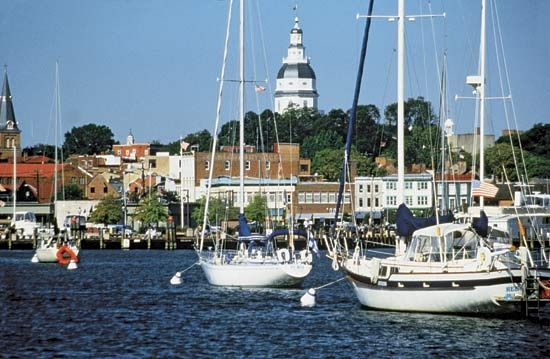Annapolis
Maryland, United States
 capital of the U.S. state of Maryland and seat of Anne Arundel county. The city lies along the Severn River at its mouth on Chesapeake Bay, 27 miles (43 km) southeast of Baltimore.
capital of the U.S. state of Maryland and seat of Anne Arundel county. The city lies along the Severn River at its mouth on Chesapeake Bay, 27 miles (43 km) southeast of Baltimore.Settled in 1649 as Providence by Virginian Puritans, it later was known as Town Land at Proctor's and Anne Arundel Town. In 1694 the colonial capital was moved there from St. Mary's City (Saint Marys City). The next year it was renamed to honour Princess Anne (Anne), who later, as queen, gave it a charter (1708). Annapolis patriots, like those of Boston, had a “tea party,” on October 19, 1774, forcing the owner of the brig Peggy Stewart to burn his ship and cargo of taxed tea. George Washington (Washington, George) resigned (December 23, 1783) as commander in chief of the Continental Army before the U.S. Congress in session there (November 26, 1783–June 3, 1784). The city avoided involvement in the battles of the American Revolution, the War of 1812, and the American Civil War, though many Civil War wounded were hospitalized there. The Annapolis Convention, held in 1786, was a precursor to the Constitutional Convention of 1787.
 A port city, Annapolis has boatyards in Eastport and is the home port for a large number of private sailing vessels and other pleasure boats. The old waterfront area, with its city dock, once the home port for the Chesapeake oyster fleet, is now a yacht harbour. City life focuses largely on state government and the United States Naval Academy. The academy (founded 1845), which occupies the site of old Fort Severn, has a 338-acre (137-hectare) campus built on the river; the naval hero John Paul Jones (Jones, John Paul) is buried in its chapel crypt. The Naval Academy Museum displays relics of American naval history and has a large collection of ship models. Graduation of the midshipmen in late May is preceded by parades, concerts, and other events.
A port city, Annapolis has boatyards in Eastport and is the home port for a large number of private sailing vessels and other pleasure boats. The old waterfront area, with its city dock, once the home port for the Chesapeake oyster fleet, is now a yacht harbour. City life focuses largely on state government and the United States Naval Academy. The academy (founded 1845), which occupies the site of old Fort Severn, has a 338-acre (137-hectare) campus built on the river; the naval hero John Paul Jones (Jones, John Paul) is buried in its chapel crypt. The Naval Academy Museum displays relics of American naval history and has a large collection of ship models. Graduation of the midshipmen in late May is preceded by parades, concerts, and other events.St. John's College (Saint John's College) was chartered (1784) as a continuation of King William's School (1696). The city's colonial heritage is preserved in many remaining buildings. The Colonial Annapolis Historic District contains the Maryland State House (1772–79), the oldest state capitol still in legislative use, where Congress ratified (January 14, 1784) the Treaty of Paris (Paris, Peace of) ending the Revolution; the Old Treasury (1735–37); St. Anne's Episcopal Church (founded 1692); and more than 60 pre-Revolutionary houses, including the homes of three signers of the Declaration of Independence—William Paca, Samuel Chase (Chase, Samuel), and Charles Carroll (Carroll, Charles). Inc. 1708. Pop. (1990) 33,187; (2000) 35,838.
- Pleuromeia
- pleuronectiform
- pleuropneumonia
- Pleurothallis
- Pleven
- Pleven, René
- Pleven, Siege of
- Pleyel, Ignace Joseph
- Pleyel, Marie-Félicité-Denise
- Pliensbachian Stage
- pliers
- Plievier, Theodor
- Plimsoll line
- Plimsoll, Samuel
- Plinthosol
- Pliny the Elder
- Pliny the Younger
- Pliocene Epoch
- Pliohippus
- plique-à-jour
- Plisetskaya, Maya
- Plisnier, Charles
- Plitvice Lakes
- plié
- PL Kyōdan